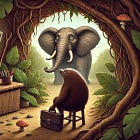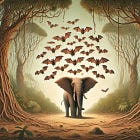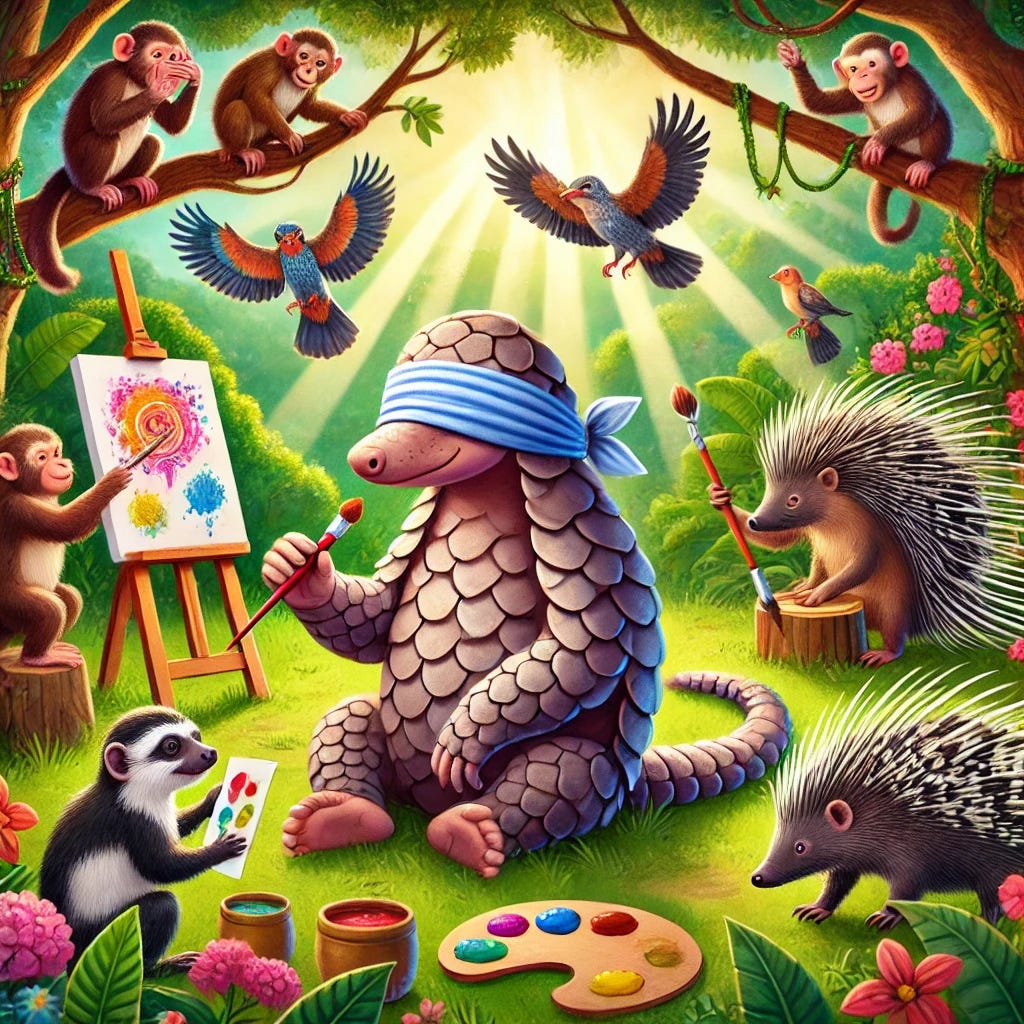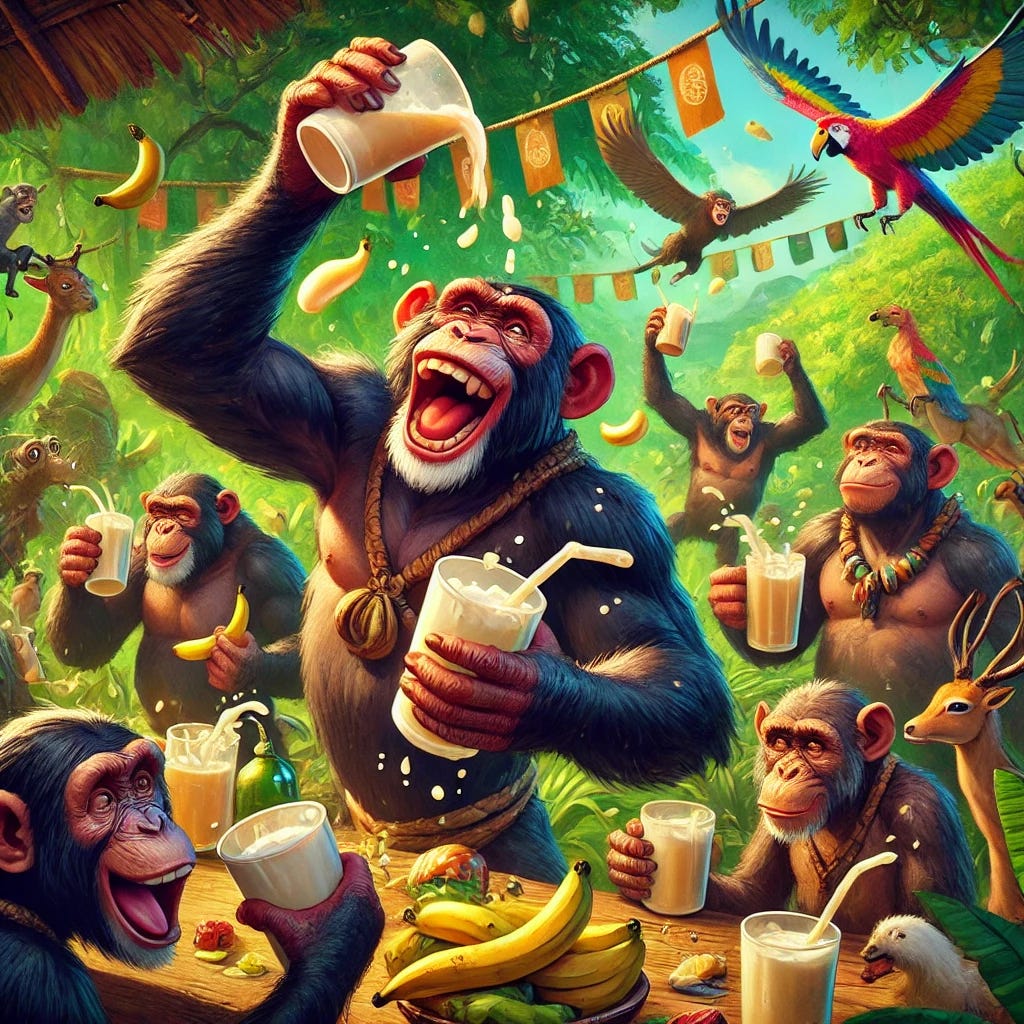Charismatic Chimpanzees Charm and Perfect Panic in the Pangolin
A Cycle of Misunderstood Wisdom
The jungle had faced one disaster after another because its leaders kept misunderstanding the Elephant. First, the Mole, blind and overly focused on rules, thought the Elephant was a tree and handed leadership to a Beaver. The Beaver built a giant dam, leaving many animals homeless. Then, the Bat, dazzled by appearances, believed the Elephant was a giant bat, a magical messenger from the sky. But instead of wisdom, they chose the Peacock, charmed by a “magical feather.” This led to a strange cult all about beauty. After that, the Committee of Owls, who blinded themselves during the day to focus on abstract ideas, decided the Elephant’s trunk was a snake. They chose the Parrot, who could only repeat meaningless phrases, to lead instead. Now, it was the Pangolin’s turn to decide if the Elephant could lead. The entire jungle was watching.
Previous in the Jungle
The Pangolin’s Tactile Truth
The Pangolin, blind but guided by their sensitive paws, sat at the heart of the jungle. Here, they oversaw what they believed was the spirit of culture. Around them, animals painted with berry juice and read clumsy poems that sounded more like growls. The Pangolin believed deeply in finding meaning through touch. To them, culture was the jungle’s soul.
When the Elephant arrived, the Pangolin carefully felt their massive body. They explored every part with care until their paws landed on the Elephant’s belly.
“What’s this? A drum?” the Pangolin asked, tapping it. A deep sound echoed through the air.
The Pangolin’s face lit up. “A living drum! You must be a great musician!”
The Elephant tilted their head and replied calmly, “I’m not a drum. But I carry rhythms—the rhythm of footsteps, the rhythm of life.”
The Pangolin leaned closer. “Culture needs more than riddles. Show us your talent!”
The Elephant smiled gently. “Culture doesn’t start with noise. It starts with roots. Let me show you how we can grow.”
But the Pangolin waved them off. “Your words are interesting, but I need someone who can dazzle. Next!”
Enter the Chimpanzee’s Charismatic Chaos
As the Elephant walked away, the Chimpanzee bounded into the clearing, spinning a vine like a lasso. “Behold!” they shouted. “The spirit of the jungle has arrived!”
Without stopping, the Chimpanzee leapt into an energetic performance. They flipped, swung from branches, and juggled coconuts. Each move came with a dramatic narration: “This is the leap of hope! This is the spin of joy! And this...”—they landed with a dramatic pose—“...is the dance of life!”
The crowd roared with applause. Holding up a banana like a trophy, the Chimpanzee declared, “This is not just a fruit! It’s a reminder to live boldly and celebrate wildly!”
The Pangolin clapped their claws together. “What passion! What energy! You, Chimpanzee, will be our Cultural Leader. Inspire us all!”
The Chimpanzee bowed low. “Thank you! My first act will be to launch the Banana Bonanza Bazaar, a celebration of fun and life! Together, we’ll reach new heights!”
The Rise and Rot of the Banana Bonanza
At first, the Banana Bonanza Bazaar was a huge success. Animals came from everywhere to see fruit sculptures, synchronized vine-swinging, and banana-themed shows. The Chimpanzee’s main act, “The Banana Bonanza Bazaar,” became wildly popular.
But problems soon began. The Chimpanzee declared, “Bananas aren’t just food—they’re art! Art needs sacrifices! And what greater sacrifice than to create Boma—the greatest drink the jungle has ever known!”
Boma, a sweet and powerful drink made from fermented bananas, quickly became the center of the festival. Animals eagerly handed over their bananas to keep the Boma flowing. But as the drink’s fame grew, their food supplies dwindled. The animals began to notice they had less and less to eat.
The Crows, always skeptical, were the first to leave. They eyed the festival’s extravagance with suspicion, but it was Boma’s intoxicating power that drove them away. “A drink that clouds the mind? This is no celebration—it’s madness!” an elder Crow cawed. With a flap of their wings, the Crows flew off, leaving an uneasy silence behind.
Discord in the Wake of Excess
As the festival continued, cracks began to show. Without enough bananas to eat, many animals started to struggle. The Porcupines, protesting the festival’s excess, used their quills to create sculptures that mocked the event. The Hyenas turned the festival into a joke, holding fake performances that made fun of its extravagance. Meanwhile, the Peacocks claimed only feathered animals could create “real” art, adding to the chaos.
The jungle’s lively spirit began to fade. Arguments broke out over the shrinking resources, and the Banana Bonanza Bazaar grounds grew eerily quiet, except for the sounds of hungry animals and the occasional squabble. Overwhelmed, the Pangolin decided to act. They crafted a drum from a hollow log and animal hide, believing its beat could restore harmony.
The drum’s sound echoed through the jungle, but only the smallest animals—mice, frogs, and squirrels—seemed to hear it. Inspired by the rhythm, they began gathering extra nuts and seeds, expanding their homes as if preparing for something unseen.
But the larger animals ignored the Pangolin. The Hyenas, once mischievous, now hunted giraffes not for food but for the laughs. The jungle’s unity was shattered, its culture in ruins.
Desperate, the Pangolin tried again and again to restore order but couldn’t stop the infighting. What started as a celebration had become chaos, leaving the animals longing for balance they could no longer find.





